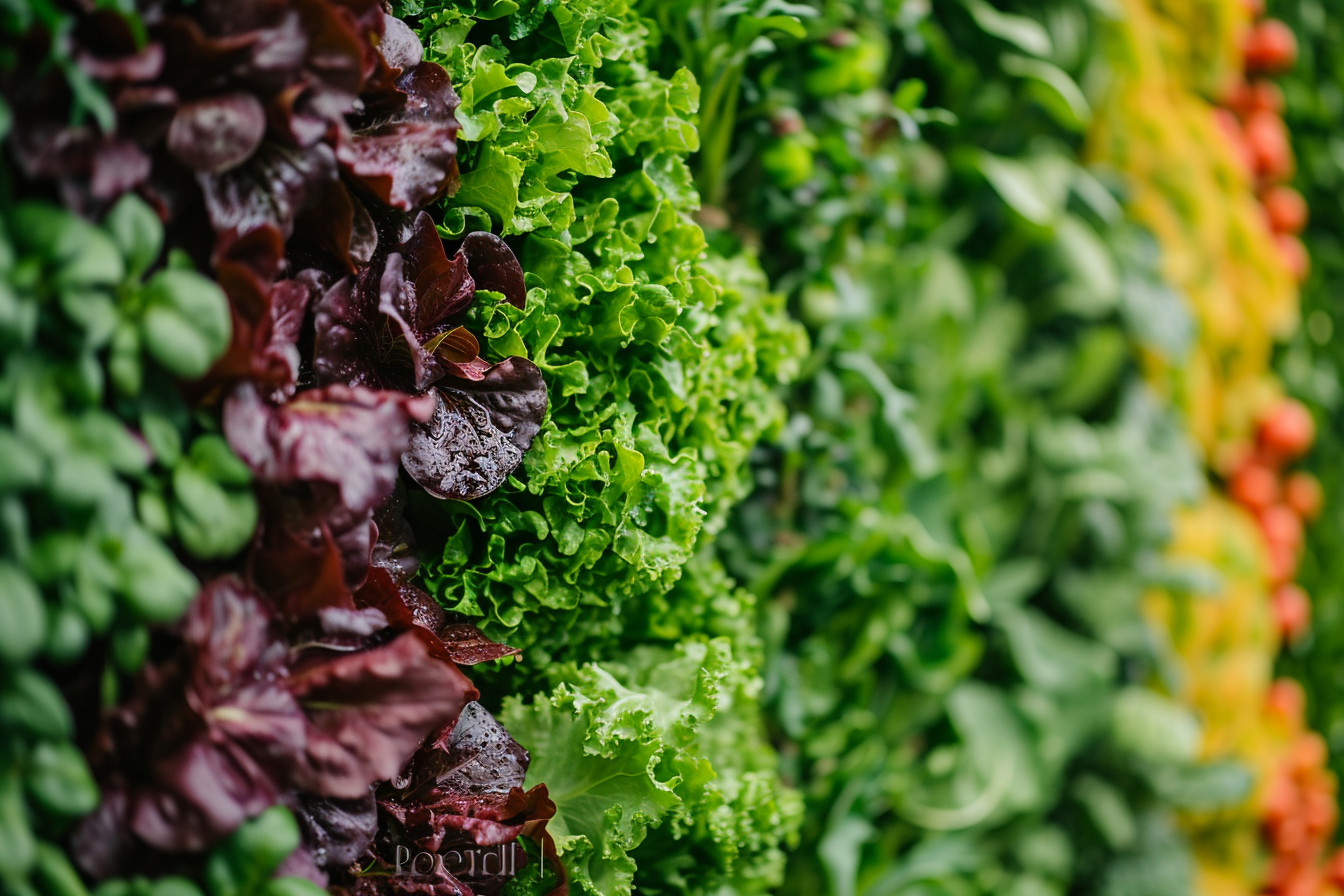I’ve always found a certain peace in tending to my garden, a tranquil connection to the earth that’s as nourishing for the soul as it is for the body. There’s something almost meditative about watching plants thrive, especially when space is at a premium and you’ve got to think up rather than out.
I’m all about sharing the nitty-gritty of gardening in a way that’s super accessible, no matter if you’re a green thumb or a newbie. Today, I’m diving into the best veggies for your vertical garden – a real game-changer for urban gardeners or anyone looking to max out their yield in minimal space.
And let me tell you, there’s a story in every vine and stalk. From personal trial and error to the collective wisdom of the gardening community, I’ll walk you through the ins and outs of growing up, literally. So, let’s get those vertical gardens flourishing with the best veggies that’ll make your neighbors green with envy.
The Benefits of Vertical Gardening
I’ve found that vertical gardening isn’t just a fabulous solution for space constraints—it’s a different way to experience the tranquility of tending to plants. There’s something genuinely harmonious about looking up at my wall of greens; it’s like Mother Nature’s taken up residence right in my backyard.
As I weave through my vertical oasis, I can’t help but appreciate how little land is needed for such an abundant harvest. I remember reading that vertical gardens can increase yield per square foot because you’re growing upwards. Now, picture this: lush greenery climbing up trellises, with ripe tomatoes winking at you from above.
Efficient water usage is another ace up the sleeve of vertical gardening. With gravity’s help, water trickles down from the top levels, ensuring every plant gets its share before draining away. It’s a smart, eco-friendly approach that conserves water and reduces runoff—a real bonus for those dry spells.
Let’s talk about accessibility. I’m not getting any younger, and the thought of stooping over traditional garden beds doesn’t always appeal to me. With vertical gardens, maintenance is pretty much at arm’s level. No bending over, no backaches, just me and my plants, face to face.
A Personal Touch to Vertical Vegetable Selection
When it comes to picking the best veggies for my vertical garden, I like to think about the view. I want veggies that are not only tasty but also add a dash of color and texture to my green wall. Here are a few favorites:
- Climbing peas and beans — They’re born to climb and require minimal support.
- Cherry tomatoes — These guys thrive vertically and are a treat right off the vine.
- Leafy greens — They make a lush backdrop and are super easy to harvest.
- Herbs — Imagine a fragrant wall of basil, mint, and oregano within arm’s reach.
Choosing the Right Vegetables for Vertical Gardens
Stepping into my garden, it strikes me every time—the harmony, the sense of connection to the earth. It’s more than just growing food; it’s cultivating tranquility. Vertical gardening adds a twist to this ancient practice, and I’ve learned that selecting the right veggies is crucial for success.
Climbers and Crawlers are the go-to choices for vertical gardens. But it’s not just about what grows up; it’s also about what hangs down. I like to think of my garden as a living tapestry, plants intertwining to create a verdant wall of greens.
- Cucumbers: They’re practically built for climbing. With a sturdy trellis, these plants can rise up, making for easy picking come harvest time.
- Squash and Melons: These viny plants can be a challenge with their heavier fruits, but with the right support, they become stars of the vertical space.
- Sweet Potatoes: Not many would think of them, but with a bit of encouragement, their vines can create a lush curtain of greenery.
When planning, consider the Sun’s Pathway. Leafy greens thrive in partial shade, so placing them below more sun-hungry veggies makes use of every beam of sunlight. Remember, vertical gardening is about thinking in layers.
Don’t let the term “Hydroponics” scare you off; it’s simpler than it sounds. Imagine growing lettuce without traditional soil, just water and nutrients. It’s clean, efficient, and incredibly satisfying. This method can be a boon for vertical gardens, as it reduces weight and simplifies watering.
I’m often asked about the sustainability of vertical gardening. Through my experiences, I’ve noted a significant decrease in water usage, thanks to drip irrigation systems and hydroponics. Our ancestors devised ways to grow crops with minimal water, and now we’re adapting those principles to modern life.
Let’s not forget Herbs. An absolute must for any vertical garden.
- Mint, with its refreshing fragrance, is a delight.
- Basil provides an aromatic backdrop and pairs beautifully with tomatoes.
- Chives, with their delicate onion flavor, are both ornamental and functional.
Tomatoes: The King of Vertical Gardening
When I think about the staples of vertical gardening, tomatoes instantly come to mind. They’re like the monarchs of the garden, reigning over their lush green domain with vibrant reds and yellows. There’s a calming simplicity in tending to these plants, and if you ask me, there’s nothing quite like plucking a ripe tomato straight off the vine.
Tomatoes are incredibly versatile, and they thrive in vertical setups due to their natural tendency to grow upward. I’ll often start my tomato plants indoors, letting them get a head start before the last frost says its final goodbye. Once they’re strong enough, it’s out to the vertical garden they go, where stakes or cages support their climb toward the sun. And here’s a tip: always make sure you’re planting varieties that are known to climb or trail, like ‘Indigo Rose’ or ‘Sweet Million’, to get the best results in a vertical setup. These types are just perfect for small spaces, offering a bountiful harvest without the sprawling footprint of traditional garden fare.
Utilizing Vertical Space
Leveraging vertical space is pivotal, and there’s a technical term I love for this – espalier. It’s a practice that involves training plants to grow against a flat surface, like a wall or trellis. Not only does this save valuable real estate in my garden, but it also minimizes disease by improving air circulation around the plants. It’s like giving them each a little bubble.
Choosing the Right Varieties
Here’s some food for thought when selecting your tomato varieties:
- Cherry tomatoes are a fantastic choice for vertical gardens. They’re prolific producers and can be grown in hanging baskets or trellises.
- Beefsteak tomatoes might require a bit more support due to their weight, but they’re definitely worth the extra effort for that big juicy bite.
- Heirloom varieties bring a sense of history to your garden. They have stories to tell, and cultivating them let’s me become a part of their ongoing legacy. Plus, they often boast flavors that are simply impossible to find in your regular supermarket selection.
Climbing Beans: High Yields in Limited Space
When I step into my garden, I find a sanctuary where the rippling leaves and gentle climb of beanstalks offer a kind of quiet company that’s hard to find anywhere else. It’s not just a hobby; it’s a way to connect with something bigger than myself. And growing climbing beans in a vertical garden embodies this peaceful harmony between function and nature.
Climbing beans are a top pick for vertical gardens for several reasons. For one, they’re prolific producers. Give them a bit of support, and they’ll cover it in no time with vibrant greenery and abundant pods. I’ve watched my trellises become lush towers of life, all from a few unassuming seeds.
Caring for climbing beans brings a simple joy that speaks to the soul. In my experience, you’ll start with the basics – plant them in well-drained soil and give them a sturdy structure like a trellis or netting to clamber up. As they grow and weave their way upward, it feels like they’re thanking you for every drop of water and beam of sunlight you’ve guided their way.
For those new to the joys of gardening, there’s a bit of charm in understanding the terms. Think of vining – it simply refers to the bean’s natural tendency to reach and curl, seeking support and sunlight. And fixing nitrogen, a phrase that sounds so scientific, is just their way of giving back to the earth, enriching the soil as they grow.
I’d like to share a slice of history to ground us a bit. Vertical gardening isn’t a new-age concept. It’s been a part of human cultivation for centuries. Early civilizations used climbing plants like beans to maximize their yields in small spaces. Today, we’re rediscovering these techniques in our urban jungles, rekindling a connection with our ancestors through the tendrils of our garden beans.
My vertical garden taught me the beauty of yield in small spaces. In one season, my setup, with no more than a few square feet, easily produced over 5 pounds of green beans. They’re not just space-savers; they’re generous givers in the garden.
Leafy Greens: Nutrient-packed and Space-efficient
There’s something deeply calming about tucking into my garden each morning. The lub-dub of my heart slows as I meander through the aisles but it’s not until I reach my vertical patch do I really feel in sync with nature. Rows upon rows of vibrant leafy greens reach up toward the sun, a testament to both their simplicity and resilience. They don’t sprawl across vast fields; instead, these vertical wonders climb skyward, making the most out of every square inch.
In my years of experimenting with vertical gardens, I’ve found that leafy greens are among the easiest and most rewarding plants to grow. They thrive in the compact spaces and seem to burst with flavor when grown off the ground. Let’s dig into why these greens are a stellar choice for any vertical garden enthusiast.
Kale, spinach, swiss chard – these are the staples of a health-conscious gardener, and mine are no exception. They’re jam-packed with vitamins and minerals, and their versatility in the kitchen is unmatched. But it’s not just about the health benefits; it’s the efficiency of these plants that really shines. Leafy greens have a remarkably small footprint, making them perfect for the tight quarters of a vertical setup.
For beginners, I always recommend starting with spinach. It’s forgiving, grows quickly, and can be harvested multiple times. Just when you think you’ve picked it clean, give it a week and you’ll likely see tender new leaves ready to be snipped off. Now, if you want something with a bit of a challenge, try kale. It can be a little pickier about its conditions but man, once it gets going, it’s a leafy powerhouse. The important thing is to ensure that each plant gets enough life-giving sunlight, so arranging your garden east to west is key – you want every level to have its time in the sun.
You might be thinking that these plants need a lot of water. The truth is, they kind of do, but the beauty of vertical gardens is the ability to set up efficient drip irrigation systems. Water at the top trickles down to the lower plants, reducing waste and your water bill.
Tips and Tricks for Successful Vertical Gardening
As I often share with friends who drop by to admire my leafy haven, a successful vertical garden is more than just a visual delight; it’s a deeply serene experience that offers a tranquil connection with nature. When we intertwine our daily lives with the gentle rhythms of gardening, we don’t just cultivate plants; we nurture a sense of peace within ourselves.
Let’s dig into the nitty-gritty with some tips from my personal gardening journal.
- Start with the setup. Make sure your vertical garden has a sturdy structure. Whether it’s trellises, wall planters, or stacks of shelves, durability is key. You don’t want your peaceful green space turning into a pile of broken pots and scattered soil.
- Next, let’s talk about the roots. Roots need more attention in vertical gardening. I’ve found that using a mix of peat, perlite, and vermiculite provides a lightweight and nutritious environment for those underground lifelines.
Here’s a Gardening Glossary to clip and save:
- Peat: partially decayed plant matter found in bogs – it’s great for holding moisture.
- Perlite: a volcanic glass that’s been heated to pop – it improves aeration.
- Vermiculite: a mineral that expands with heat – it soaks up water like a sponge.
You could say they’re the holy trinity of vertical garden substrates.
Another crucial pointer is the selection of veggies that not only grow up but also thrive in tight spaces. Let me share a shortlist:
- Radishes are the sprinters of the vegetable world. They grow quickly.
- Lettuces add a splash of green and they’re pretty low-maintenance.
- Strawberries for a sweet vertical treat; they love high-rise living.
But it isn’t just about stacking and packing. It’s the tranquility of threading water lines through your mini jungle, the hush of dawn as you check for sprouts, and the rhythm of nature’s soundtrack as your backdrop.
When considering irrigation, drip systems are your best friend for efficiency. They deliver just the right amount of water directly to the roots, avoiding waste and overwatering. It’s also a mesmerizing sight to see droplets of water make their ways to thirsty plants, one drop at a time.
Final Thought
So there you have it—my take on the best veggies to tuck into your vertical garden. Whether you’re short on space or just looking to add a bit of green to your balcony or wall, vertical gardening’s a fantastic way to go. Remember to give your plants the right mix of soil, keep that water flowing with a smart system, and choose veggies that love growing up rather than out. Trust me, there’s nothing quite like plucking a fresh cherry tomato or snipping off some basil right from your living room. Happy gardening!









